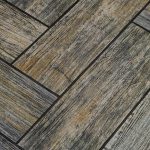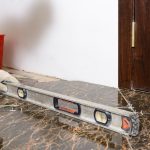When it comes to choosing floor tile for your Madison WI home there are dozens of options. You face decisions on color, texture, size and shape. Fortunately, there’s a tile just right for your floors. It just takes time and thought to choose the best one, along with a trip to a Madison WI tile shop.
The majority of tile going on floors in Madison area homes come from the category “Large Format.” That means they’re big. To fit this class a single tile has to be at least 15-inches on one side. Popular sizes range from 12- by 24-inches all the way up to 24- by 48-inches (2-feet by 4-feet!). On the other end of the scale there are plenty of smaller tiles ideal for small spaces like bathrooms. There’s a tile for your floor no matter how expansive or small.
While large format floor tile looks great, there are drawbacks, especially if you’re a do-it-yourselfer. It takes at least two people, sometimes three, to handle these big, heavy pieces safely. And, it takes specialized tools to cut them.
What’s hot when it comes to tile on the floor? Here are a few of the trends leading the way in Madison for 2021:
- Natural stone is the most sought-after material for tile floors.
- Slate is the No. 1 stone choice for large spaces.
- Glazed porcelain tile is the No. 1 seller for floor applications after natural stone. There are dozens of choices. Porcelain accounts for nearly all the sales in nonporous tiles which is critical for anything going on the floor.
- Ceramic tile is making its way into the flooring arena but isn’t as durable as other options.
Another drawback to natural stones is their likelihood to stain. They require more maintenance and must be sealed — and resealed periodically.
Evaluate Floor Tile Features

For the look of hardwood with the durability of tile consider the high-tech porcelain creations using digital printing technology.
There are several basic features of every tile option worth considering before you select one for your floor. Evaluate these when the tile is going on the floor in a high traffic area or a space where dirt, debris and water are likely:
- Hardness – measured on the Moh scale, tile hardness numbers indicate how it stands up to wear – foot traffic, scratches, etc. The ratings range from 1 to 10. Bright, glossy glazes tend to rank poorer than matt finishes. Tiles are ranked in classes:
- Class I – no foot traffic, appropriate for walls only.
- Class II – light traffic with no source of scratches or on walls – use in bathrooms, etc.
- Class III – Moderate traffic as tile for floors plus use on walls and countertops. Fine for rooms other than kitchen, entryways, laundries, etc.
- Class IV – OK for heavier traffic including kitchens, halls and entryways.
- Class V – designed for heavy traffic areas with dirt and debris. Ideal for commercial space.
Class IV tile is the most common choice for floors and any room of your house.
- Porosity – measured by the ratio of air bubbles to solids in tile, it impacts how each piece absorbs water. In a bathroom, kitchen, laundry or mudroom where moisture is common, highly porous tiles are not a good idea. Porosity is classifications include:
- Impervious – water absorption is less than half a percent. Ideal for all the rooms of your house.
- Vitreous – absorbs up to 3% of water on its surface.
- Semi-vitreous – absorbs up to 7%
- Non-vitreous – absorbs more than 7% and definitely not recommended for use on the floor.
Floor Tile All Through The House
The selection of flooring for every room in the house has expanded in recent years. There are many “hard floor” options including real wood, laminates, high-tech vinyl and floor tile. Tile has stepped up to represent an excellent choice in virtually every room. If you like real hardwood floors but don’t want the maintenance, how about wood-look tile planks?
No matter where you plan to install tile on the floor, there’s another major component to consider – Slip Resistance.
Some tile is slipperier than others, especially when wet. A tile’s slip resistance is measured by its coefficient of friction (COF). For tiles on the floor you want the highest COF you can find. As a rule, larger tiles with more exposed surface area tend be to slipperier. That’s why smaller tiles are so common on the floor of showers. Makes sense, right? When choosing flooring tiles here are a few facts to remember:
- Some ceramic and porcelain tiles have specially textured surfaces and slip-resistant coatings.
- Slate is extremely popular for floors and is naturally slip-resistant.
- Small size tiles of any kind have more grout lines making the floor surface more textured and therefore more slip-resistant – where water is likely (bathrooms, etc.) big isn’t always better.
If you’re looking for an all-around tile for your home porcelain is the leading contender. Porcelain tiles provide strength, moisture-resistance and many design and color options. They’re durable and can be used on floors and walls with equal success throughout the house.
Tile For The Kitchen Floor
Kitchen renovations are popular remodeling projects. Breathing life into a dated space with a new tile floor is a great way to start. Porcelain is the leading choice for kitchen floor because it is budget-friendly, versatile and easy to clean.
Do you want a kitchen floor treatment that has friends and family stepping back for a second look? Consider wood-look or marble-like porcelain tiles. These high-tech designer tiles are made using the latest in computer design technology. Wood grains and stone patterns are printed on the tile surface with digital ink-jet printers before the final stage of the manufacturing process.
Colorful encaustic tiles (cement based) will also liven up a traditional kitchen floor with color and bold graphics.
If you’re dealing with a relatively small space, bold graphics may not be the best choice. To take advantage of all the available natural light and make the space appear larger, go with light colored floor tile. While pure white might be a chore to keep clean, especially if there are kids and pets in the house, other colors work. Consider sand, beige, cream or gray. Larger tiles help make a room appear larger, too. A designer tip – installing the same tile on a wall helps to keep the illusion of more space going.
Natural Stone Floors – High-quality, Great Look
For both the look and durability of high-end flooring it’s hard to beat natural stone. Marble, granite, slate and travertine all provide an extra touch of elegance. And, because not two pieces are exactly alike each installation is truly one-of-a-kind. Stone flooring excels in the new large format sizes. Using large tiles on the floor has the added advantage of fewer grout lines. Large stone floors look almost seamless.
While stone must be sealed when it goes down, a good sealant last 5-10 years depending upon wear. Grout with sealant included in the mix is an ideal choice for installation without extra work.
There are several popular types of natural stone from which to choose, each with pros and cons. As you plan a tile floor project with real stone, consider:
- Slate tile on the floor – slate is the most common flooring tile, especially in the Madison area. It is easy to work with when creating tile, but not very easy to work with when it comes to installation. It takes experience, skill and the right tools to do a slate tile floor right.
- Limestone tiles – limestone is a calciferous stone related to travertine but it’s harder and therefore more resilient as flooring. It’s a beautiful stone that often looks like wood. Its biggest drawback is that it absorbs water more easily than some other options so sealing is critical.
- Sandstone flooring – sandstone is available in fewer color variations than other stones so it’s easier to create consistent tones on floors. The lack of color choices is also a drawback for some.
- Granite – the hardest of the natural stones, it holds a shine that shows off its wide range of colors.
There’s A Floor Tile For Your Madison Home
Architectural trends come and go but the versatility of tile stays constant. No matter the vintage of style your home represents, there’s a tile to fit your floor.
Two stone varieties that have slipped in popularity should still be mentioned. They have a place. When scouring the media for flooring ideas you’ll likely see these mentioned:
- Travertine tile – it’s often mistaken for marble or limestone but it stands alone. It’s softer and hard to shine but its natural matt finish is warm and attractive. It does scratch and can stain but it isn’t as fragile as reports suggest. The Trevi Fountain in Rome was made from travertine; it’s lasted about 300 years, so it must be pretty robust, right?
- Marble floors – marble is an “old standby” among flooring tiles. It stains and scratches easily but nothing says elegance like marble. It’s beautiful but need professional maintenance on a regular basis. Maybe that’s why it isn’t as popular as other options here in the Midwest.
When you’ve evaluated the choices make an appointment to visit Madison’s most complete tile showroom. Molony Tile is the area’s No. 1 tile resource. Your first look around will open your eyes. Can you imagine how many different tiles there are to look at? Be prepared to be introduced to options you never knew existed.


